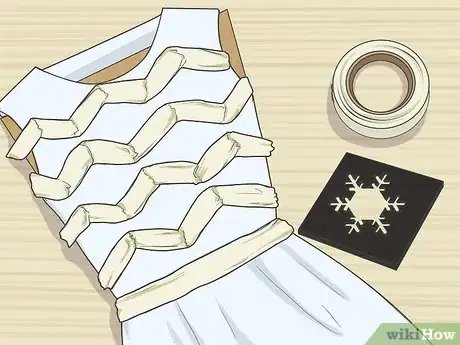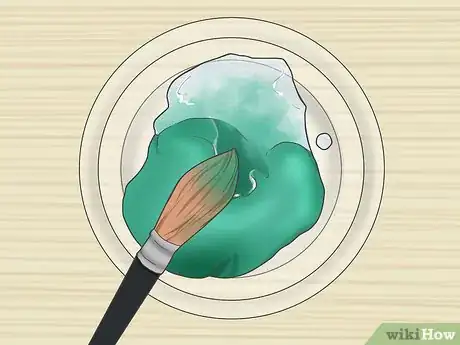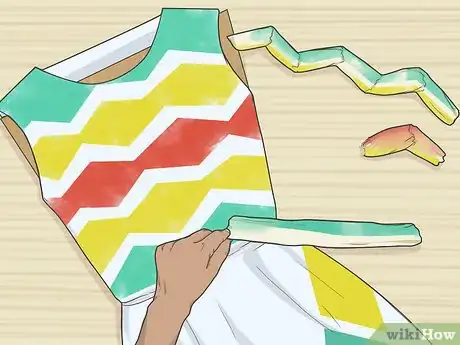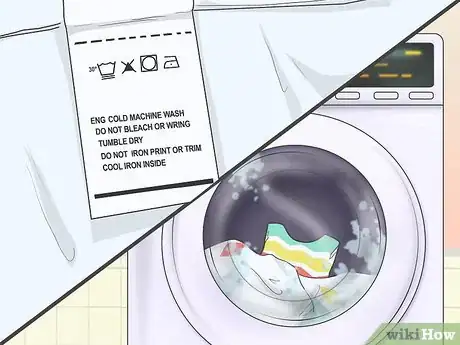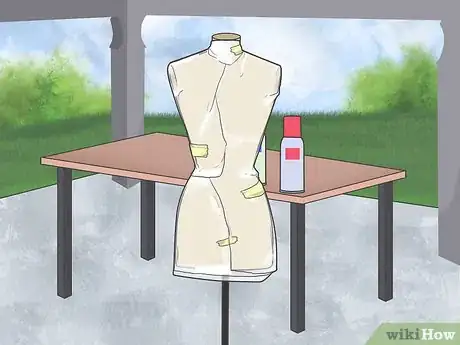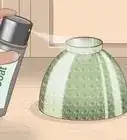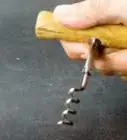This article was co-authored by wikiHow Staff. Our trained team of editors and researchers validate articles for accuracy and comprehensiveness. wikiHow's Content Management Team carefully monitors the work from our editorial staff to ensure that each article is backed by trusted research and meets our high quality standards.
This article has been viewed 15,169 times.
Learn more...
Painting a dress is a great way to take it to the next level and make it truly unique. The simplest way to paint the dress is to spread it out on a flat surface and apply fabric paint with a brush. If you want an airbrushed look, however, you'll need to put the dress onto a dress form, then apply fabric spray paint instead.
Steps
Brushing Paint onto a Dress
-
1Set the dress on a flat surface and tuck cardboard inside it. The cardboard should be big enough to fit inside the dress. If you're only painting a small area, however, choose a piece of cardboard that's a little bit bigger than your design.
- The cardboard will prevent the paint from soaking into the back of the dress.
- Make sure that the cardboard is behind the area that you'll be painting.
- If the cardboard is not big enough for the painted design, you'll have to work in smaller sections and move the cardboard around as you paint.
-
2Apply masking tape or stencils, if desired. Self-adhesive stencils work the best for fabric, but you can use regular stencils too—just be sure to tape down the edges. Alternatively, you can create stripes, zigzag, or other geometric patterns with pieces of masking tape.
- You don’t have to do this if you don’t want to; you can paint the designs free-hand.
Advertisement -
3Dilute your fabric paint with water. Pour some brush-on fabric paint onto a pallet or into a small dish, then stir in a few drops of water. Keep adding water until you get the translucency you like. The more water you add, the more translucent the paint will be, sort of like watercolor paints.
- Use a few drops of water if you want to make the paint thick enough for details.
- Don't use more than a 1-to-4 ratio of water to paint, otherwise it will be too thin.
- Don't use puffy paint or dimensional fabric paint. It's not the same thing.
-
4Apply the paint with a synthetic paintbrush or a foam brush. There is no right or wrong way to do this. You can apply random strokes of paint to create an abstract design, or straight, parallel strokes for a neater touch. If you are using a stencil, however, tap the paint on with a pouncer, starting from the outside edges of the stencil.
- Use small, pointy brushes for details and wide, flat brushes for larger areas. Foam brushes will also work for large areas.
- A pouncer is a type of foam brush, but instead of a chisel-shape, it's cylindrical. You can find it in the stencil or tie dye section of a craft store.
-
5Let the fabric dry completely, then remove any tape or stencils. If the fabric is very wet or has a lot of paint on it, it would be best to leave it flat. If you only applied a little bit of paint and the fabric is mostly dry, you can hang it up.
- Don't hang wet fabric, or the paint will bleed and run.
- How long the paint takes to dry depends on the brand that you are using. In most cases, you'll only have to wait 15 to 20 minutes.
-
6Iron the dress according to the instructions on the paint bottle. In most cases, you'll have to cover the painted area with a thin cloth, then iron it using the highest setting that's safe for your fabric. Press the paint for 30 seconds at a time.
- Synthetics can handle warm iron temperatures, while cotton can handle hot.
- Ironing the painted design is important because it will set the paint and make it permanent.
-
7Wash the dress according to the care tag and paint label. Be aware that in some cases, you'll have to choose the safer option. For example, if the tag on the dress says to tumble dry warm, but the paint label say to hang dry, then hang the dress out to dry. This is because air-drying is safe for both the dress and the paint.
- In most cases, handwashing the garment in cold water, then hanging it out to dry is your safest bet.
- If the dress says to dry clean, check the paint label. If the paint label doesn't say anything, ask your dry cleaner and read the paint's website for more information.
Using a Dress Form and Spray Paint
-
1Find a well-ventilated place to work in. This method works the best with spray paint, so working in a well-ventilated area (preferably outside) is a must. Make sure that the area is easy to clean. A grassy lawn would work well, but you can cover the floor with newspaper too.
- Don’t cover the floor with plastic, especially if this is a floor-length dress, as the paint can puddle under the hem.
-
2Cover a dress form with plastic wrap. Bring the dress form into the area that you’ll be working in first. If it’s adjustable, adjust it to fit the dress, then cover it with plastic wrap. This will help keep the dress form clean.[1]
- If you don't own a dress form, you can make a duct tape dress form instead.
- If you can't make a duct tape dress form, stuff the bodice of the dress with a pillow. If you don't want the pillow to get ruined, put it into a plastic bag first.
-
3Put the dress on the dress form. Zip, button, or lace the dress up so that it is nice and snug on the dress. Be sure to smooth out any ripples or wrinkles. If this is a floor-length formal dress, spread the skirt out.
- If you are using a duct tape mannequin, stand it up on a chair or hang it up so that the dress's skirt doesn't bunch up.
- If you stuffed your dress's bodice with a pillow, put the dress on a hanger, then hang it up. Don't let the skirt bunch up on the floor.
-
4Mask off the areas you don't want to paint. For example, if you want to paint just the bottom of the dress, lay strips of masking tape or painters tape along the bottom portion of the dress to create a seam, like in a coloring book picture.[2]
- For more specific shapes, use self-adhesive fabric stencils.
-
5Choose a fabric spray paint, then shake it for 60 seconds. You can also use spray paint made for silk flowers. Do not use regular spray paint, however, or it will dry too stiff.[3] Once you’ve selected your paint, shake the can for 60 seconds. This is important; if you don’t shake the can, the paint and propellant won’t mix properly.[4]
- Silk flower spray paint comes in more colors than fabric spray paint, but it can also rub off. It’s not a good option for a dress that you'll be wearing regularly.
-
6Apply a light coat of paint to the dress. There really is no right or wrong way to do this. You can spray the paint on using horizontal, overlapping strokes for all-over coverage, or you can spray it on randomly for a unique effect. You can use just a single color or multiple colors.[5]
-
7Let the paint dry, then apply 1 to 2 more coats, if needed. The paint may look alright at first, but once it absorbs into the fabric, it may look patchy. If this happens to you, simply apply another coat of paint using the same technique as before and let it dry.[6]
- You may need to apply 2 to 3 coats of paint total.
- How long the paint takes to dry depends on what you are using. Expect to wait around 15 to 20 minutes; double-check the paint label to be sure, however.
-
8Remove the masking tape or stencils once the paint has dried. At this point, you can fill in any chips with spare paint and a small brush. If you want to soften any hard lines created by the masking tape, just spray over the edge to soften it up.[7]
- Once the paint has dried, you can remove the dress from the dress form.
-
9Iron the dress to set the paint, if needed. Most types of fabric paints need to be ironed in order to stick. Double-check the label to be sure, however. You should also read the care tag inside the dress as not everything can be ironed.
- Heat setting the fabric helps make the paint permanent, allowing you to wash the garment. You may not be able to dry clean it afterwards, however.
- If you can’t iron the fabric, then you can’t heat set the paint. You will have to be extra careful with the dress and spot-clean it only.
-
10Read the dress's care tag and the paint's label for washing directions. If the paint says that it's not waterproof, then you won't be able to wash the dress. You may be able to dry clean it, but ask the dry cleaners. In most cases, handwashing the dress in cold water and then hanging it out to dry would be the best.
- Sometimes, you'll have to choose the safer option. For example, if the dress says "warm water" and the paint says "cold," stick with cold water.
Things You'll Need
Brushing Paint onto a Dress
- Dress
- Cardboard
- Fabric paint
- Synthetic paintbrush or foam brush
- Small dish or paint pallet
- Masking tape (optional)
- Fabric stencils (optional)
- Iron (for heat setting)
Using a Dress Form and Spray Paint
- Dress form or duct tape mannequin
- Plastic wrap
- Fabric spray paint
- Masking tape (optional)
- Fabric stencils (optional)
- Iron (if needed, for heat setting)
References
- ↑ https://www.youtube.com/watch?v=BHMKs4jmj5g
- ↑ https://www.youtube.com/watch?v=Na_njKYQKEg&feature=youtu.be&t=36s
- ↑ https://www.youtube.com/watch?v=Na_njKYQKEg&feature=youtu.be&t=42s
- ↑ https://www.apartmenttherapy.com/diy-project-test-lab-results-we-tried-3-fabric-paints-on-upholstery-and-heres-what-happened-218302
- ↑ https://www.youtube.com/watch?v=Na_njKYQKEg&feature=youtu.be&t=49s
- ↑ https://www.apartmenttherapy.com/diy-project-test-lab-results-we-tried-3-fabric-paints-on-upholstery-and-heres-what-happened-218302
- ↑ https://www.youtube.com/watch?v=Na_njKYQKEg&feature=youtu.be&t=1m20s

